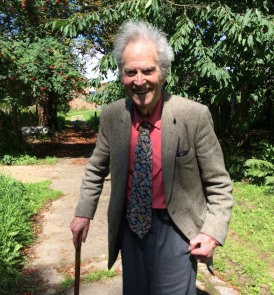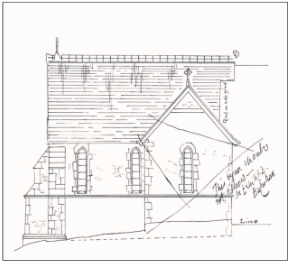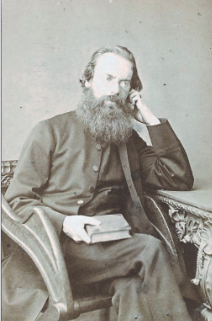


THE WOES OF VICTORIAN CLERGY IN FARNBOROUGH
Have you ever wondered what life was like for a Victorian curate at Farnborough church; why the parish has an association with Emmanuel College Cambridge; how Farnborough became an independent parish in 1876, and what all this has to do with the Lubbocks? Well perhaps this article will help shed some light on events that took place in our village 150 years ago.
 |
Some ten years ago Geoffrey Copus (pictured left in 2011) , well known researcher particularly of
Chelsfield, had been looking at the Archbishops’ correspondence and
Visitation returns for late Victorian times, held at Lambeth Palace
Library, and the Faculty papers at Canterbury Cathedral Library. Some
fascinating material came to light, revealing that all was not well in
Downe and Farnborough. It is salutary to read, near the end of the article, that debates over proposals to make changes to the structure of St. Giles church are not just a recent phenomenon. |
Geoffrey Copus died in June 2018 aged 88. I had been urged to meet him and have a chat, but never made it.
This article was written by him in 2011, and is reproduced here by kind permission of the Bromley Borough Local History Society
Nick Reynolds November 2020
Wesleyans, Baptists, Infidels and Heathens.
The Lubbock family's connection with our area began in 1809, when John William Lubbock, a wealthy London banker, acquired the High Elms estate with some 260 acres in Downe and Farnborough. The estate descended to his grandson John Lubbock, later created Lord Avebury, who was distinguished in scientific circles. Charles Darwin came to live in Downe in 1842, when he purchased Down House, and the Darwin and Lubbock families, who shared many interests, became very friendly, and both are mentioned in the ecclesiastical records at Lambeth Palace.The Archbishops’ Visitations there contain much which is of great interest, not just for the church historian. The questionnaires drawn up for the Visitations, held at intervals of several years by the Victorian Archbishops, are incredibly detailed. In 1872, Archbishop Longley’s questions to his parochial clergy had 37 main headings, with many sub-divisions. The Rev George Sketchley Ffinden had been instituted as Vicar of Downe in the previous year, and the picture he painted of the parish in his response was a gloomy one. He also attached to his return a letter to the Archbishop, in which he wrote:
“...considering that the leading families are either Infidels or Dissenters ... humanly speaking, owing to their example, I do not see any prospect of an increase in the number of Church people.”
In 1876 he was more specific—in response to question 17, about the reason why
“the congregation does not bear a fair proportion to the population”,
he wrote:
“The deficiency is to be attributed to the leading families, Sir J Lubbock and Mr Darwin and others being Socinians and Infidels.”
In 1880 he wrote:
“About half of the parishioners are not Anglican but Wesleyans, Baptists, Infidels and Heathens.”
The Lubbock family, who supported the Church in a general way, really did not deserve the epithets heaped on them by Mr. Ffinden. It is not surprising, therefore, that in protest at his attitude they moved their allegiance from Downe to Farnborough church, where they seem to have settled down quite happily. Oddly enough, a photograph of Mr. Ffinden, also at Lambeth, shows that he sported an immense beard, and had an uncommonly simian appearance, as seen in Victorian cartoons sparked off by the controversies about Darwin’s theory of evolution.
The Curate’s Lot is not a Happy One.
“It is scarcely possible to get a decent lodging in Farnborough even for a single man —for a married man with a family a sufficient house cannot be obtained. Mr Hingston has been living for 2 years in a very poor cottage in which his wife and child have nearly died of gastric fever.”
Permission for this change of abode was duly granted.
Folliott Baugh seems to have been a kindly, thoughtful parish priest, who had been instituted as Rector of Chelsfield with Farnborough attached to it in 1849. Some way of altering this arrangement and making Farnborough an independent parish was long overdue, but, charming as he was, Mr Baugh was also a great procrastinator —not least in the time he took to effect the severance of Farnborough from Chelsfield.
In 1875 Mr Hingston wrote to the Archbishop to enquire anxiously whether it was certain that the proposed new living of Farnborough would be given to him, as he had been promised. Evidently nothing concrete came of this and poor Mr Hingston was moved to write to the Archbishop again six weeks later:
“May I ask your Grace if you can kindly give me any fresh information as to the separation of these livings? .... I feel in a state of very great uncertainty, fearing that there may yet be some unexpected, but inevitable, hitch, which may arise to disappoint the hopes I have long been led to cherish...”
In the event, Mr Hingston was duly presented to the new, separated living of Farnborough in 1876, but it would seem that still things did not run very smoothly for him, and he continued to be dogged by ill-health. In 1884, one of his parishioners, Mr Beale, wrote to the Archbishop (then Edward White Benson) to complain of Mr Hingston’s ministry and received this reply from a Chaplain:
“From enquiries made, his Grace believes that you have not overstated the case as regards the condition of things at Farnborough. Narrow means and ill health are serious drawbacks to the efficiency of pastoral ministrations ... as you have kindly interested yourself in this case, perhaps you might be able to prevail upon some of the parishioners to guarantee the stipend of a curate.”
Benson, perhaps the best Archbishop we have ever had, never missed a trick, and his defence of Mr Hingston and suggestion that Mr Beale should himself do something about the situation is adroit, and typical of him. Mr Beale (evidently one of those people who arrive in a parish and immediately start to busybody around) could hardly demur, and responded:
“Though I have only recently come to reside here, I will do my best to prevail upon the parishioners to guarantee the stipend of a curate, beginning with £5 from myself....”
But the situation resolved itself, as a little later he wrote, rather unfeelingly perhaps:
“After all it will not be necessary to provide a locum tenens for this place as Mr Hingston died this morning...”
Selling Off the Patronage of the New Parish
This was not quite the end of the story, as there was an astonishing
twist, when All Souls College, while retaining the patronage of
Chelsfield, actually sold that of the new parish to a private
individual, who at once put it up for sale again. He entrusted the
negotiations to Mr Anthony, the Landlord of the George Inn, to the
horror of another well-off parishioner, who wrote to the Archbishop
about “the scandal of the appointment of a man whose influence we hoped would be used to stop the horrible amount of drunkenness that now exists here, being handed over to a local beerhouse keeper...”
This very odd episode eventually resolved itself satisfactorily, and the living was acquired by Emmanuel College, Cambridge, who are still patrons to this day.
Dragging Farnborough into the 19th. Century
The Rector presented by them, the Rev Frederick J. Kelly, soon set about
putting things on a sounder footing. Typical Victorian cleric as he was,
almost the first thing to which he turned his attention was restoring
and refitting St. Giles’ church to comply with the latest fashions, and
the story unfolds in the Faculty papers in Canterbury Library. All went well to start with and the plan by Joseph Clarke, the Diocesan Architect, to rebuild the chancel was approved.
A further plan to add an organ chamber was also submitted but here a serious setback occurred: the application came back, showing the north elevation of the church with the proposed organ chamber crossed through with the Archbishop's comment in his vigorous handwriting:
“This organ chamber not allowed.—EW Cantuar”.
 |
Poor Mr Kelly was distraught and wrote again, stressing that the organ
which Mr T Hamilton Fox, a prominent parishioner and employer of local
labour, proposed to give would not be presented unless the Chamber were
built as planned. He even made the rather unrealistic request that as a matter of urgency the Archbishop should come to Farnborough to see for himself that the wall it was proposed to demolish was not of an ancient character. |
The correspondence thereafter is rather confused, but there are some lively exchanges between Mr Fox and the Archbishop, and a letter from the eminent architect Ewan Christian whom the latter had evidently consulted. At one point Mr Kelly wrote rather bitterly to the Archbishop's Chaplain:
“Farnborough people are certainly more anxious to adapt the Church to the needs of worship in the present day than to preserve it as an example of what was deemed sufficient 600 years ago, and they are hard to convince” —
These are sentiments one frequently hears expressed today by incumbents anxious to modernise their buildings. The upshot was that the Archbishop (whose concern for church buildings was indeed commendable) was eventually convinced that the proposed plan was acceptable, the chamber was built, and the organ duly presented.
